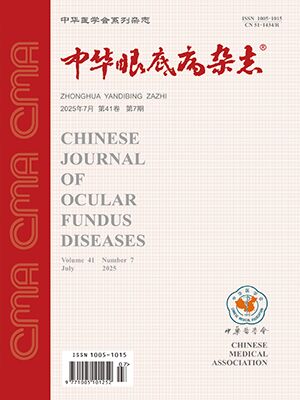| 1. |
Pritchard EM, Dyer MA, Guy RK. Progress in small molecule therapeutics for the treatment of retinoblastoma[J]. Mini Rev Med Chem, 2016, 16(6): 430-454. DOI: 10.2174/1389557515666150722100610.
|
| 2. |
Valente P, De Ioris MA, Romanzo A, et al. Advanced unilateral retinoblastoma: a case of sparing enucleation treatment failure[J/OL]. Can J Ophthalmol, 2016, 51(2): e40-43[2016-04-01]. https://pubmed.ncbi.nlm.nih.gov/27085272/. DOI: 10.1016/j.jcjo.2015.10.015.
|
| 3. |
Jabbour P, Chalouhi N, Tjoumakaris S, et al. Pearls and pitfalls of intraarterial chemotherapy for retinoblastoma[J]. J Neurosurg Pediatr, 2012, 10(3): 175-181. DOI: 10.3171/2012.5.PEDS1277.
|
| 4. |
De Potter P, Flanders AE, Shields JA, et al. The role of fat-suppression technique and gadopentetate dimeglumine in magnetic resonance imaging evaluation of intraocular tumors and simulating lesions[J]. Arch Ophthalmol, 1994, 112(3): 340-348. DOI: 10.1001/archopht.1994.01090150070026.
|
| 5. |
Ainbinder DJ, Haik BG, Frei DF, et al. Gadolinium enhancement: improved MRI detection of retinoblastoma extension into the optic nerve[J]. Neuroradiology, 1996, 38(8): 778-781. DOI: 10.1007/s002340050346.
|
| 6. |
Schueler AO, Hosten N, Bechrakis NE, et al. High resolution magnetic resonance imaging of retinoblastoma[J]. Br J Ophthalmol, 2003, 87(3): 330-335. DOI: 10.1136/bjo.87.3.330.
|
| 7. |
de Graaf P, Barkhof F, Moll AC, et al. Retinoblastoma: MR imaging parameters in detection of tumor extent[J]. Radiology, 2005, 235(1): 197-207. DOI: 10.1148/radiol.2351031301.
|
| 8. |
Brisse HJ, Guesmi M, Aerts I, et al. Relevance of CT and MRI in retinoblastoma for the diagnosis of postlaminar invasion with normal-size optic nerve: a retrospective study of 150 patients with histological comparison[J]. Pediatr Radiol, 2007, 37(7): 649-656. DOI: 10.1007/s00247-007-0491-4.
|
| 9. |
Lemke AJ, Kazi I, Mergner U, et al. Retinoblastoma-MR appearance using a surface coil in comparison with histopathological results[J]. Eur Radiol, 2007, 17(1): 49-60. DOI: 10.1007/s00330-006-0197-2.
|
| 10. |
Shields CL, Shields JA, Baez K, et al. Optic nerve invasion of retinoblastoma. Metastatic potential and clinical risk factors[J]. Cancer, 1994, 73(3): 692-698. DOI: 10.1002/1097-0142(19940201)73:3<692::aid-cncr2820730331>3.0.co;2-8.
|
| 11. |
Kopelman JE, McLean IW, Rosenberg SH. Multivariate analysis of risk factors for metastasis in retinoblastoma treated by enucleation[J]. Ophthalmology, 1987, 94(4): 371-377. DOI: 10.1016/s0161-6420(87)33436-0.
|
| 12. |
Messmer EP, Heinrich T, Höpping W, et al. Risk factors for metastases in patients with retinoblastoma[J]. Ophthalmology, 1991, 98(2): 136-141. DOI: 10.1016/s0161-6420(91)32325-x.
|
| 13. |
Murphree AL, Chantada GL. Clinical ophthalmic oncology[M]//Singh AD, Murphree AL, Damato BE. Retinoblastoma. Heidelberg New York Dordrecht London: Springer, 2015, 33-35.
|
| 14. |
Chintagumpala M, Chevez-Barrios P, Paysse EA, et al. Retinoblastoma: review of current management[J]. Oncologist, 2007, 12(10): 1237-1246. DOI: 10.1634/theoncologist.12-10-1237.
|
| 15. |
John-Mikolajewski V, Messmer E, Sauerwein W, et al. Orbital computed tomography. Does it help in diagnosing the infiltration of choroid, sclera and/or optic nerve in retinoblastoma?[J]. Ophthalmic Paediatr Genet, 1987, 8(2): 101-104. DOI: 10.3109/13816818709028525.
|
| 16. |
Jacquemin C, Karcioglu ZA. Detection of optic nerve involvement in retinoblastoma with enhanced computed tomography[J]. Eye (Lond), 1998, 12 (Pt 2): 179-83. DOI: 10.1038/eye.1998.44.
|
| 17. |
Barkhof F, Smeets M, van der Valk P, et al. MR imaging in retinoblastoma[J]. Eur Radiol, 1997, 7(5): 726-731. DOI: 10.1007/BF02742934.
|
| 18. |
de Graaf P, Moll AC, Imhof SM, et al. Retinoblastoma and optic nerve enhancement on MRI: not always extraocular tumour extension[J]. Br J Ophthalmol, 2006, 90(6): 800-801. DOI: 10.1136/bjo.2005.089383.
|
| 19. |
Cho SJ, Kim JH, Baik SH, et al. Diagnostic performance of MRI of post-laminar optic nerve invasion detection in retinoblastoma: a systematic review and meta-analysis[J]. Neuroradiology, 2021, 63(4): 499-509. DOI: 10.1007/s00234-020-02538-1.
|
| 20. |
Kim JW, Madi I, Lee R, et al. Clinical significance of optic nerve enhancement on magnetic resonance imaging in enucleated retinoblastoma patients[J]. Ophthalmol Retina, 2017, 1(5): 369-374. DOI: 10.1016/j.oret.2017.03.013.
|
| 21. |
de Jong MC, de Graaf P, Pouwels PJW, et al. 9.4T and 17.6T MRI of Retinoblastoma: ex vivo evaluation of microstructural anatomy and disease extent compared with histopathology[J]. J Magn Reson Imaging, 2018, 47(6): 1487-1497. DOI: 10.1002/jmri.25913.
|
| 22. |
Ong SJ, Chao AN, Wong HF, et al. Selective ophthalmic arterial injection of melphalan for intraocular retinoblastoma: a 4-year review[J]. Jpn J Ophthalmol, 2015, 59(2): 109-117. DOI: 10.1007/s10384-014-0356-y.
|
| 23. |
Shields JA, Shields CL, De Potter P. Enucleation technique for children with retinoblastoma[J]. J Pediatr Ophthalmol Strabismus, 1992, 29(4): 213-215. DOI: 10.3928/0191-3913-19920701-06.
|
| 24. |
Doz F, Brisse H, Stoppa-Lyonnet D, et al. Retinoblastoma[M]//Pinkerton R, Plowman P, Pieters R. Pediatric oncology. London: Arnold, 2004: 323-338.
|




